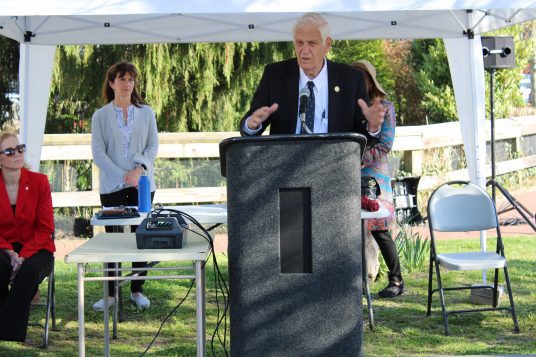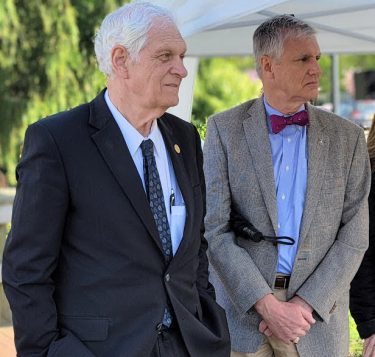Gas company is planning to develop its East Setauket property
By Mallie Jane Kim
Residents expressed grave concerns about Northville Industries’ plans to develop its East Setauket fuel tank farm at a sometimes rowdy April 29 public gathering in Ward Melville High School’s auditorium.
About 200 people attended, with several shouting out and heckling during Northville’s initial presentation, which company lawyer Tim Shea had to end prematurely to allow attendees to speak.
“We’re here to listen to everybody,” Shea said, referring to a controversial proposed driveway on Upper Sheep Pasture Road. “If everybody here says no curb cut on Sheep Pasture and the [Town of Brookhaven] agrees, it’ll be no curb cut on Sheep Pasture.”
Throughout the two-and-a-half hour meeting, which Northville hosted to see if residents prefer a within-zoning plan for large warehouses or a townhouse-style multifamily rental community that would require rezoning, Shea reiterated the company would be willing to listen and compromise — and he certainly got an earful.
Brookhaven Councilmember Jonathan Kornreich (D-Stony Brook), who was present as an observer at the meeting alongside town Supervisor Dan Panico (R), has been clear about his opposition to multifamily residences near the tanks, but Northville representatives indicated they hoped the meeting would inspire residents to petition councilmembers to approve rezoning. They also pointed out their plan has residences set back from the tanks a distance in keeping with legal requirements.
“Industrial is our highest and best use that we’re permitted to do,” said Steve Ripp, CEO of NIC Holding Corp, which owns Northville. “Multifamily is what we feel is the highest and best use in general, but would require community support to really request that.”
The answer was a resounding “neither” from most attendees, some of whom had specific concerns about impact on traffic, safety and the environment, while others expressed deep suspicion of the company’s trustworthiness.
“These people have not been good neighbors,” accused one woman who said she has spent most of her life living close enough to see the tanks from her home and worried about the impact on property values. “You’re not only taking our finances away but you’re taking away the ability for us to even enjoy our homes,” she said, suggesting the light, sound, air and noise pollution would ruin her ability to garden in peace in her backyard.
“You’ve been a thorn in this community’s side for over 50 years,” she added.
Northville’s rationale
The company’s plans to develop come with an eye toward the future and diversifying revenue streams, according to Ripp, who mentioned moves toward electrification of home heating and car engines could mean the eventual phasing out of fossil fuels.
“Obviously that’s going to have a significant impact, and our business is going to decline,” Ripp said, estimating the tanks would be phased out in about 30 years. “It would be a bad situation for Suffolk County to lose its only gasoline delivery point before the population is ready.”
He indicated the proposed industrial development could bring an estimated $600,000 in property tax to the community, while the residential project could bring about $1.5 million — with the caveat that either project may win a deferred tax relief benefit.
Ripp did not shy away from discussing the leak of 1.2 million gallons over a decade from a fuel storage tank in the 1980s, which roiled the surrounding neighborhood for years.
“Since that time, Northville has moved — in the last 35 years — tens of billions of gallons through our facilities with no operational mishaps to speak of,” he said, mentioning the company stayed open to supply fuel during Hurricane Sandy and that it hosts New York State’s strategic fuel reserve.
A subsequent search of New York State’s spill incidents database turned up seven spills on Belle Mead Road from 1998 through 2019, four of which specifically name Northville. The database does not include details, such as how big those spills were.
In a phone call, Ripp clarified that Northville must report spills as small as a gallon, so that number of minor spills over 25 years actually reinforces his assertion.”
At the meeting, he also touted Northville’s philanthropic giving and said the company doesn’t do enough to counterbalance its poor reputation in the community by sharing its good deeds.
Several attendees who spoke publicly, and those who shouted out from the audience, didn’t buy it.
“Thank you for pointing out how generous Northville Industries is, how environmentally conscious you are,” cracked one speaker, who identified himself as a business professor who has lived in the neighborhood adjacent to Northville for 27 years. He worried that if the company received a new zoning designation, they’d wind up developing the entire property, and called for the community to fight the proposals at Town Hall. “Otherwise, Northville Industries will make your life miserable,” he said.
While a couple of speakers suggested they’d prefer housing over warehouses if they had to choose, other attendees suggested the company put in a solar farm, find a way to contribute more taxes so residents could have relief, or create a philanthropic foundation to form additional greenway space on the property. The most popular suggestion was for a government entity to purchase the property to prevent development, but the price of such a move would be high, and Ripp indicated the Town of Brookhaven has not expressed an appetite for it.
Englebright calls for environmental study
One particularly hot topic for the crowd was the accusation that Northville is trying to avoid a complete environmental impact study — something lawyer Shea acknowledged Northville didn’t believe was required in this case.
As the crowd grew increasingly frustrated and passionate, Suffolk County Legislator Steve Englebright (D- Setauket), who has a long history of environmental action in state and county government, stepped up to the mic. He empathized with commenters and made clear his position that the project should trigger an environmental study with the town.
“Seven hundred trucks? Housing next to explosive liquids and vapors?” he said, to applause. “This is a critical groundwater area.”
Englebright also questioned the motives behind the meeting altogether.
“There is every likelihood that this is an initiative to scare the hell out of you to get their way on an alternative that they do not have an as of right for,” he said, and indicated he would continue watching the Northville situation.
Late in the meeting, one speaker acknowledged that Northville is a company that exists to make money, which is normal in American society, but made a call for the company to live up to its claim of being a good neighbor by listening to the concerns expressed throughout the night.
“At the end of the day, everybody from Amazon to the guy that sells Ralph’s ice cream in Port Jeff needs to make money,” he said. “Come back to the community at some point saying, ‘We heard you.’ Come back and be a good neighbor.”





















































